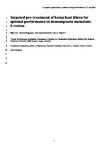Targeted pre-treatment of hemp bast fibres for optimal performance in biocomposite materials: a review
| dc.contributor.author | Liu, M | |
| dc.contributor.author | Thygesen, A | |
| dc.contributor.author | Summerscales, John | |
| dc.contributor.author | Meyer, A | |
| dc.date.accessioned | 2017-07-13T09:19:22Z | |
| dc.date.available | 2017-07-13T09:19:22Z | |
| dc.date.issued | 2017-12-01 | |
| dc.identifier.issn | 0926-6690 | |
| dc.identifier.issn | 1872-633X | |
| dc.identifier.other | INDCRO-D-17-00491R2 | |
| dc.identifier.uri | http://hdl.handle.net/10026.1/9618 | |
| dc.description.abstract |
Global interest in the use of plant fibres in natural fibre reinforced composites (NFCs) is growing rapidly. The increased interest is primarily due to the advantageous properties of natural fibres including biodegradability, low cost, low density and high stiffness and strength to weight ratio. In order to achieve strong NFCs, well separated and cellulose-rich fibres are required. Hemp is taking a center stage in this regard as a source of suitable natural plant cellulose fibres because natural hemp bast fibres are long and inherently possess high strength. Classical field and water retting methods have been used for centuries for removal of non-cellulosic components from fibrous plant stems including from hemp, but carries a risk of reducing the mechanical properties of the fibres via damaging the cellulose. For NFCs new targeted fibre pre-treatment methods are needed to selectively and effectively remove non-cellulosic components from the plant fibres and for producing cellulose rich fibres without introducing any damage to the fibres. A key feature for successful use of natural fibres such as hemp fibres in composite materials is optimal interfacial contact between the fibres and the hydrophobic composite matrix material. Targeted modification of natural fibres for NFCs must also be targeted to optimize the fibre surface properties. Consequently, improved interfacial bonding between fibres and hydrophobic polymers, reduced moisture uptake, increased microbial degradation resistance, and prolonged durability of NFCs can be achieved. This review, using hemp bast fibres as an example, critically and comprehensively assesses the targeted pretreatment technologies and data available for producing well separated cellulose bast fibres having optimal chemical and physical properties for maximizing the mechanical performance and durability of NFCs. | |
| dc.format.extent | 660-683 | |
| dc.language | en | |
| dc.language.iso | en | |
| dc.publisher | Elsevier | |
| dc.subject | Hemp fibres | |
| dc.subject | mechanical properties | |
| dc.subject | stiffness | |
| dc.subject | tensile strength | |
| dc.subject | natural-fibre composites | |
| dc.title | Targeted pre-treatment of hemp bast fibres for optimal performance in biocomposite materials: a review | |
| dc.type | journal-article | |
| dc.type | Review | |
| dc.type | Journal | |
| plymouth.author-url | https://www.plymouth.ac.uk/staff/john-summerscales | |
| plymouth.volume | 108 | |
| plymouth.publication-status | Published | |
| plymouth.journal | Industrial Crops and Products | |
| dc.identifier.doi | 10.1016/j.indcrop.2017.07.027 | |
| plymouth.organisational-group | /Plymouth | |
| plymouth.organisational-group | /Plymouth/Faculty of Science and Engineering | |
| plymouth.organisational-group | /Plymouth/Faculty of Science and Engineering/School of Engineering, Computing and Mathematics | |
| plymouth.organisational-group | /Plymouth/REF 2021 Researchers by UoA | |
| plymouth.organisational-group | /Plymouth/REF 2021 Researchers by UoA/UoA12 Engineering | |
| plymouth.organisational-group | /Plymouth/Research Groups | |
| plymouth.organisational-group | /Plymouth/Research Groups/Marine Institute | |
| plymouth.organisational-group | /Plymouth/Users by role | |
| plymouth.organisational-group | /Plymouth/Users by role/Academics | |
| dcterms.dateAccepted | 2017-07-13 | |
| dc.rights.embargodate | 2018-7-27 | |
| dc.identifier.eissn | 1872-633X | |
| dc.rights.embargoperiod | 12 months | |
| rioxxterms.versionofrecord | 10.1016/j.indcrop.2017.07.027 | |
| rioxxterms.licenseref.uri | http://www.rioxx.net/licenses/under-embargo-all-rights-reserved | |
| rioxxterms.licenseref.startdate | 2017-12-01 | |
| rioxxterms.type | Journal Article/Review |


